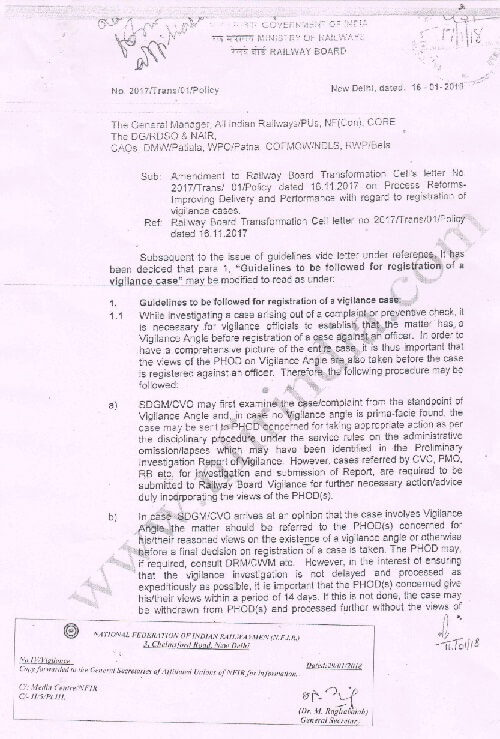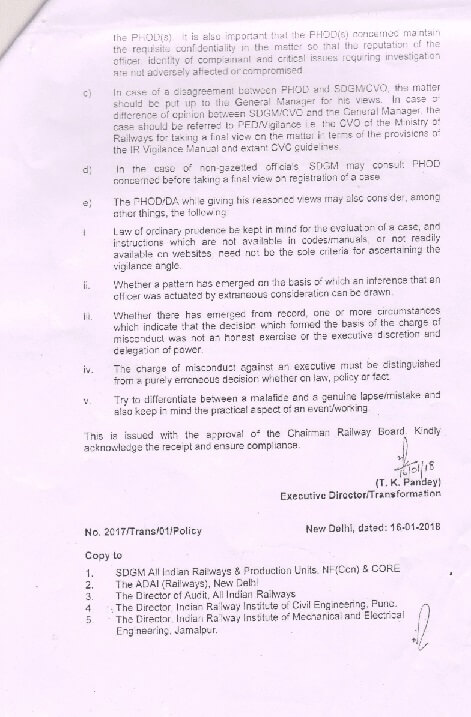रेल मंत्रालय / MINISTRY OF RAILWAYS
रेलवे बोर्ड
/ RAILWAY BOARD
No.2017/Trans/01/Policy
The General Manager, All Indian Railways/PUs, NF(Con), CORE
The DG/RDSO & NAIR,
Sub: Amendment to Railway Board Transformation Cell’s letter No. 2017/Trans/ 01/Policy dated 16.11.2017 on Process Reforms- improving Delivery and Performance with regard to registration of vigilance cases.
l. Guidelines to be followed for registration of a vigilance case :
1.1 While investigating a case arising out of a complaint or preventive check, it is necessary for vigilance officials to establish that the matter has a Vigilance Angle before registration of a case against an officer. In order to have a comprehensive picture of the entire case, it is thus important that the views of the PHOD on Vigilance Angle are also taken before the case is registered against an officer. Therefore the following procedure may be followed:
a) SDGM/CVO may first examine the ease/complaint from the standpoint of Vigilance Angle and, in case no Vigilance angle is prima-facie found, the case may be sent to PHOD concerned for taking appropriate action as per the disciplinary procedure under the service roles on the administrative omission/lapses which may have been identified in the Preliminary Investigation Reort of Vigilance However, cases referred by CVC, PMO, RB etc, for investigation and submission of Report, are required, to be submitted to Railway Board Vigilance for further necessary action/advice duly incorporating the views of the PHOD(s).
b) In case SDGM/CVO arrives at an opinion that the case involves Vigilance Angle the matter should be referred to the PHOD(s) concerned for his/their reasoned views on the existence of a vigilance angle or otherwise before a final decision on registration of a case is taken. The PHOD may, if required, consult DRM/CWM etc. However, in the interest of ensuring that the vigilance investigation is not delayed and processed as expeditiously as possible, it is important that the PHOD(s) concerned give his/their views within a period of 14 days. If this is not done, the case may be withdrawn from PHOD(s) and processed further without the views of the PHOD(s), it is also important that the PHOD(s) concerned maintain, the requisite confidentiality in the matter so that the reputation of the officer, identity of complainant and critical issues requiring investigation are not adversely affected or compromised.
c) In case of a disagreement between PHOD and SDGM/CVO, the matter should be put up to the General Manager for his views. in case of difference of opinion between SDGM/CVO and the General Manager, the case should be referred to PED/Vigilance i-e. the CVO of the Ministry of Railways for taking a final view on the matter in terms of the provisions of the IR Vigilance Manual and extant CVC guidelines.
e) The PHOD/DA while giving his reasoned views may also consider, among other things, the following:
i. Law of ordinary prudence be kept in mind for the evaluation of a case, and instructions which are not available in codes/manuals, or not readily available on websites, need not be the sole criteria for ascertaining the vigilance angle.
ii. Whether a pattern has emerged on the basis of which an inference that an officer was actuated by extraneous consideration can be drawn.
iii. Whether there has emerged from record, one or more circumstances which indicate that the decision which formed the basis of the charge of misconduct was not an honest exercise or the executive discretion and delegation of power.
iv. The charge of misconduct against an executive must be distinguished from a purely erroneous decision whether on law, policy or fact.
v. Try to differentiate between a malafide and a genuine lapse/mistake and also keep in mind the practical aspect of an event/working.
This is issued with the approval of the Chairman Railway Board. Kindly acknowledge the receipt and ensure compliance.
Executive Director/Transformation



COMMENTS